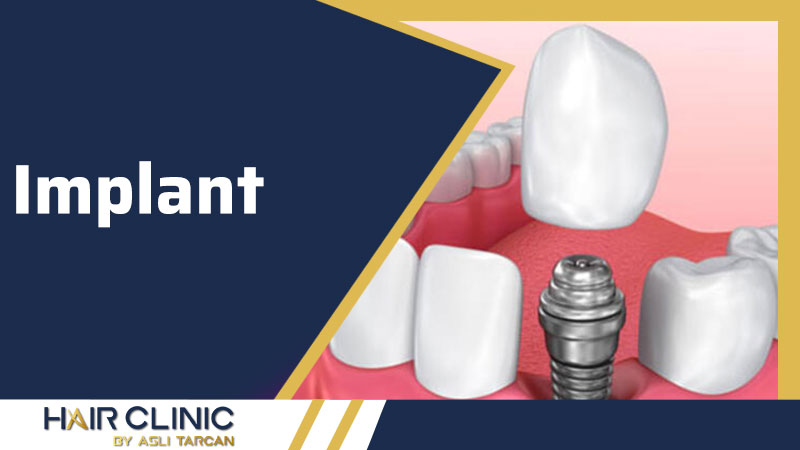Implant Today, you have more options than ever to replace a missing tooth. As an alternative to traditional options, many patients choose a dental implant because it is almost the same copy of the natural structure of your teeth. They regenerate your entire tooth, including the root. Here are the steps you can look forward to on your journey with a full smile.
Although you can practice good oral hygiene habits at home, such as brushing your teeth regularly and flossing, in addition to other steps you can take, emergencies, infections, and bruises can have bad consequences. These circumstances can lead to tooth loss, some teeth, or even partial or total tooth loss. In this case, however, our clinic can help you improve your smile with the help of a dental implant.
When you have lost a tooth
Tooth loss can occur through many circumstances, from infection and illness that may have progressed before you knew it, to emergency dental catastrophes such as tooth decay and more. When there is no chance of saving a broken or broken smile and a gap is created in your smile, you may want to consider an implant.
A dental implant offers a solution to restore your smile with a natural copy. During the procedure, the surgeon will insert a titanium implant into your jaw, where the replacement will be located. After insertion of the pole, the jaw bone will begin to heal around it, forming a tight bond that will make the titanium pole mimic the bond of a root to the jaw. After that, the dentist will create a restoration to replace the crown you have lost. When you do this, a color matching material is used to mimic the color of your smile to give it a vibrant look.
When some teeth are missing
Not only can the restoration process complete your appearance by filling in a gap, but it can also be used to treat a missing tooth section. The procedure is similar to the one described above and depending on how many teeth and how they relate to each other, your dentist may offer a partial denture or bridge to complete your smile.
What are dental implants?
Dental implants are small points of titanium that our dentist can surgically place in the jaw. For a period of months, the implants fuse naturally with the bone tissue, making it a permanent part of your anatomy and providing a secure base for an implant-supported crown, bridge, or denture.
Dental implant counseling at home
Dental implants can cure any serious tooth loss – from a single tooth to the entire arch. In general, if you have good oral and overall health, you can restore your smile with dental implants. However, you will still need a thorough consultation with your dentist.
In addition to a visual examination, we will look at a CT scan of your oral structures to look for possible concerns, such as infection or low bone density. We will also take the time to discuss your medical history and lifestyle. Based on the test results, you may need additional treatments before proceeding with your plan.
Dental implant surgery
You have scheduled the implant placement surgery after you have healed from previous procedures. Your oral surgeon uses sedation or anesthesia to ensure you are comfortable as your gum tissue is open to access your jaw. Computer-guided technology is used to locate the exact location of a small hole in your jaw. A titanium insert is inserted into the hole and your tissue is sewn closed.
Dental implant treatment takes several months to complete and requires multiple appointments. However, the natural, functional smile you will have in the end is worth it.
Here is what you can expect during the treatment …
Implant surgery
Your first appointment involves implant placement. Our doctors will first numb the area before making a small incision in the gums. It will then insert the sites through the gums and jaw. We usually place an implant in place of any missing tooth, but it depends on the type of restoration you need.
Osteointegration
Now, the sites will remain in healing for four to six months. During this period, the implants are completely fused to the surrounding bone through a process known as osteointegration. Our dentist can offer you temporary restoration for use during this period.
Supports
Once the osteointegration procedure is complete, you will return to our clinic for a second surgery. Our doctor will attach connector pieces known as braces to the implants. The braces will soon attach titanium implants to your prosthetic teeth. After this secondary surgery, the second course of treatment is required in a few weeks.
Rehabilitation planning
After placing the braces, the doctor will take impressions of your bite and send them to our partner dental lab, where experienced technicians will do your restorations. In patients who are missing a tooth only a crown is required, while we may suggest a bridge or denture supported by an implant for patients who are missing many teeth.
Position
Finally, you will return to our clinic to receive your full smile. The doctor will check the location and appearance of the implant-supported restoration and make the necessary adjustments. Once we are satisfied with the results, we can attach the artificial teeth to your implants.
Osteointegration of dental implants & placement of a brace
Acting as a root, it stimulates new bone growth. Your jaw will merge into the suspension through a process called osseointegration. It will take several months, but it is a very good time to ensure that the replacement tooth has a strong foundation to function naturally.
Once your jaw has healed, you will need a second procedure to attach an arm to the suspension. This is a connecting piece between the crown and the implant. During this period, we will also receive a digital impression from your mouth as you begin to create your recovery.
Provision of dentures with implants
Restorations are not limited to a few teeth, either. If you have complete tooth loss and are looking for dentures, it is important to know that you have options there as well. Traditional dentures are created and applied with paste to attach them to the gums, while implant dentures are secured with titanium positions that are strategically placed on all lines of the gums, offering a safer smile and intense bite.
Dental restoration placement
As you recover from the support process, the dental laboratory will repair your new tooth. It is made to match your exact specification to look natural while also being durable. Once your gum tissue is finished and healed, you will return to our office to attach it to your brace.
Candidates for dental implants
Good oral Heath
To be eligible for an implant, patients must have good oral health (in addition to losing their teeth.) If you have other conditions such as periodontal disease, we must address these concerns before starting implant treatment.
Sufficient bone density
Patients must have a sufficient amount of jaw bone density to support the embedded sites. If you have extensive bone atrophy, the doctor may recommend a bone graft procedure to restore your candidacy.
No smoking
Smoking can affect the body’s ability to heal after implant surgery and increase the risk of complications. If you smoke, we recommend that you stop several months before treatment and avoid it throughout the recovery period.
The benefits of dental implants
Dental implants are considered the gold standard of care for the replacement of missing teeth. This is because dental implants provide tremendous benefits compared to traditional crown and bridge treatments and removable dentures, such as:
- Easier, more comfortable food, speech, and smile
- A more attractive, natural smile with artificial teeth
- Improved jaw bone health and prevention of bone damage
- Better durability than traditional restorations
- Resistant to tooth decay and infection
- You do not need to dry adjacent healthy teeth to hold a bridge or modify adjacent teeth with removable bridge fittings
- You do not need to use messy adhesives (denture creams) to hold a denture in place
- Easy care with regular brushing and flossing
Dental implants also provide many quality of life benefits, such as improved oral health, the ability to enjoy all your favorite foods, better nutrition (hence improved systemic health), increased social confidence, and reduced risk of chronic treatment.
Long life
Dental implants are a long-term solution for missing teeth. While crowns, bridges, or dentures attached to implants will eventually require replacement, the implants themselves can remain in place for a lifetime.
Preservation of the jaw
When a tooth is lost, the spine loses stimulation from the roots of the teeth and begins to weaken. Dental implants are the only treatment option that acts as prosthetic roots of the teeth, preventing this process of bone atrophy.
Functional smile
While a traditional denture often slips out of place when you talk or eat, an implant-backed restoration remains as stable as natural teeth. Implants allow you to chew your favorite foods and laugh with confidence.
Affordable dental implants
Affordable dental implants have been used for several decades. In fact, many dentists consider them as the standard of care for tooth replacement. Although their placement involves surgery, treatment has become largely affordable so that patients can enjoy the many benefits of dental implants, such as:
How much will a dental implant cost you?
The cost of a dental implant placement depends on several factors, such as the location of the oral implant, the experience of the oral surgeon performing the procedure, and the location of the dental practice. This amount corresponds to the surgery for the placement of the implant, the cost of all the components involved in the procedure, and the cost of crown replacement.
A dental implant placement procedure may include the following:
- Tooth extraction This is usually the first step in dental implant surgery. Any tooth fragments must be completely removed to allow proper site preparation before insertion of the dental implant.
- Site Preparation If the implant site shows signs of bone loss after tooth extraction, your orthopedic surgeon may recommend a bone graft or augmentation of the sinuses to build bone tissue and achieve a solid base to support the implant.
- Implant placement When the site is ready, a dental implant (titanium position) will be placed in the bone using a special drill and tools. The surgeon will then place a “treatment cap” over the implant before suturing the gums.
- Treatment You will have to wait 2-6 months for the area to heal and for the implant to be embedded in the bone tissue. A temporary denture will be placed in the area for aesthetic purposes. You will need follow-up visits for the oral surgeon to monitor treatment.
- Boom Installation Once the implant is successfully implanted in the bone, a brace will be attached to the implant using a screw. A general dentist can then take the impression of the brace and send it to the dental laboratory to do the custom.
- Tooth replacement When the crown is ready, it will be fixed to the arm with cement or a screw. Keep in mind that the choice of material for your crown will also affect the cost of dental implants.
How much will the insurance pay?
In most cases, dental insurance does not cover the placement of dental implants. This is because most insurance providers consider dental implants to be selective surgery, although they have become widely known as the standard of care for tooth replacement. However, some dental insurance providers cover the cost of obtaining a custom crown.
How our team can help you
Whether you want to replace a single missing tooth or a complete set of teeth, our clinic can help you find the implant solution that works best for you.
If you are ready to invest in dental implants, the implant dentist at our clinic can help you. Take your first step towards a full smile by scheduling your consultation contact our clinic today for an appointment. We provide the highest level of dental restoration. Whether you are missing a single tooth or all of your teeth, you can have a beautiful, functional smile once again with dental implants.



